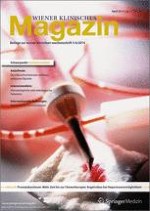Anzeige
01.04.2014 | Interventionelle Radiologie
Mechanische Thrombektomie
Ein bereits etabliertes Behandlungskonzept?
Erschienen in: Wiener klinisches Magazin | Ausgabe 2/2014
Einloggen, um Zugang zu erhaltenZusammenfassung
Die endovaskuläre Schlaganfalltherapie hat sich seit ihrer Einführung zunehmend, vor allem in den letzten Jahren, weiterentwickelt. In dieser Übersicht wird ein Resümee der bisherigen Möglichkeiten, hauptsächlich der mechanischen Rekanalisierung, gegeben. Diese stellt heute die am weitesten verbreitete und nach aktuellen Studien die erfolgreichste Methode der endovaskulären Therapie dar. Das deutlichste Entwicklungspotential hatte hierbei die Einführung der stentähnlichen Retriever. Auch nach den 2013 erschienenen randomisierten Studien ist das allgemeine Fazit, dass nach Patientenselektion eine endovaskuläre Therapie mit einem modernen Stent-Retriever durchaus das klinische Outcome verbessern kann. In diesen Studien wurden lediglich ältere Geräte oder ein lokal rekombinanter gewebespezifischer Plasminogenaktivator (rtPA, „recombinant tissue-type plasminogen activator“) verwendet, jedoch keine Stent-Retriever. Damit wird u. a. auch dadurch die Dateninterpretation etwas eingeschränkt und die Diskussion durchaus kontrovers.
Was kann also als aktueller Konsens angesehen werden? Für die A.-basilaris-Thrombose ist die endovaskuläre Therapie die mittlerweile akzeptierte Methode der Wahl. Im vorderen Kreislauf gelten nach Studienlage die langstreckigen Thromben als Indikationen für das endovaskuläre Vorgehen. Zudem sind für die Patientenauswahl wichtige bildgebungsgestützte Parameter entwickelt worden. Falls notwendig, können in der akuten Phase auch Gefäßdilatationen erfolgen; das Einbringen eines Stents ist möglich, muss aber aufgrund der erforderlichen Thrombozytenfunktionshemmung gut abgewogen werden.
Weitere Studien, die randomisiert die i.v.-Thrombolyse und die Thrombektomie mit modernen Geräten vergleichen sollen, sind nun wichtig und derzeit in Planung oder gerade begonnen worden. Patienten, bei denen eine Thrombektomie erwogen wird, sollten in diese Studien eingeschlossen werden.
